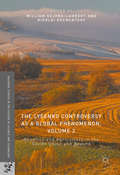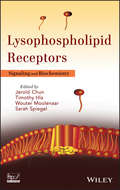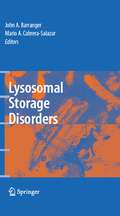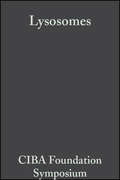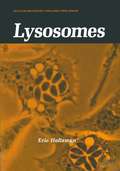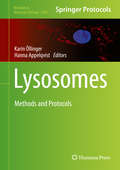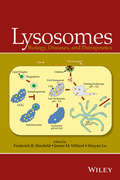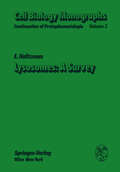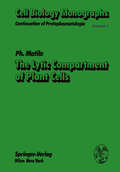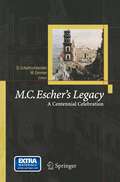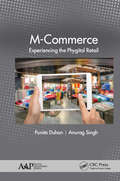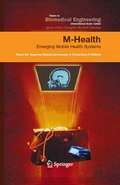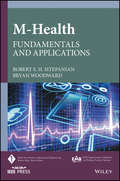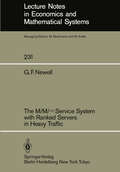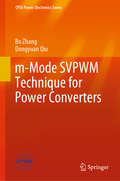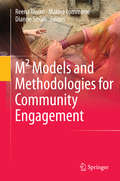- Table View
- List View
The Lysenko Affair
by David JoravskyThe Lysenko affair was perhaps the most bizarre chapter in the history of modern science. For thirty years, until 1965, Soviet genetics was dominated by a fanatical agronomist who achieved dictatorial power over genetics and plant science as well as agronomy. "A standard source both for Soviet specialists and for sociologists of science."—American Journal of Sociology "Joravsky has produced . . . the most detailed and authoritative treatment of Lysenko and his view on genetics."—New York Times Book Review
The Lysenko Controversy as a Global Phenomenon, Volume 1: Genetics and Agriculture in the Soviet Union and Beyond
by William Dejong-Lambert Nikolai KrementsovThis volume covers the global history of the Lysenko controversy, while exploring in greater depth the background of D. Lysenko’s career and influence in the USSR. By presenting the rise and fall of T.D. Lysenko in a variety of aspects—his influence upon art, unrecognized predecessors, and the extent to which genetics continued in the USSR even while he was in power, and the revival of his reputation today—the authors provide a fresh perspective on one of the most notorious episodes in the history of science.
The Lysenko Controversy as a Global Phenomenon, Volume 1: Genetics and Agriculture in the Soviet Union and Beyond
by William Dejong-Lambert Nikolai KrementsovThis volume covers the global history of the Lysenko controversy, while exploring in greater depth the background of D. Lysenko’s career and influence in the USSR. By presenting the rise and fall of T.D. Lysenko in a variety of aspects—his influence upon art, unrecognized predecessors, and the extent to which genetics continued in the USSR even while he was in power, and the revival of his reputation today—the authors provide a fresh perspective on one of the most notorious episodes in the history of science.
The Lysenko Controversy as a Global Phenomenon, Volume 2: Genetics and Agriculture in the Soviet Union and Beyond
by William Dejong-Lambert Nikolai KrementsovThis volume examines the international impact of Lysenkoism in its namesake’s heyday and the reasons behind Lysenko’s rehabilitation in Russia today. By presenting the rise and fall of T.D. Lysenko in its various aspects, the authors provide a fresh perspective on one of the most notorious episodes in the history of science.
The Lysenko Controversy as a Global Phenomenon, Volume 2: Genetics and Agriculture in the Soviet Union and Beyond
by William Dejong-Lambert Nikolai KrementsovThis volume examines the international impact of Lysenkoism in its namesake’s heyday and the reasons behind Lysenko’s rehabilitation in Russia today. By presenting the rise and fall of T.D. Lysenko in its various aspects, the authors provide a fresh perspective on one of the most notorious episodes in the history of science.
Lysophospholipid Receptors: Signaling and Biochemistry
by Jerold ChunThe current state of the science supporting new research in lysophospholipids The study of lysophospholipids exploded with the discovery of cell surface receptors on both lysophosphatidic acid (LPA) and sphingosine 1-phosphate (S1P). Since then, thousands of original research reports—ranging from fundamental cell signaling to the physiology and pathophysiology of individual organ systems—have centered on lysophospholipids. This book draws together and analyzes the current literature to provide readers with a state-of-the-science review as well as current techniques that support research in all aspects of the field of lysophospholipid signaling. Lysophospholipid Receptors is divided into three sections: Receptors and other possible effectors Enzymes Physiology and pathophysiology Within each section, the authors explain the similarities and differences between LPA and S1P signaling. Examples are provided that demonstrate the underlying mechanisms of lysophospholipid signaling across a broad range of organ systems, such as S1P signaling in cardiovascular physiology and disease and the neural effects of LPA signaling. Extensive references at the end of each chapter provide a gateway to the literature and facilitate further research into individual topics. Each chapter has been authored by one or more leading international authorities in lysophospholipid research. Based on a thorough analysis of the current research, the authors set forth what is established science and offer their expert opinion and perspective on new and emerging areas of research, setting the stage for further investigations that will solve current problems in the field.
Lysophospholipid Receptors: Signaling and Biochemistry
by Jerold ChunThe current state of the science supporting new research in lysophospholipids The study of lysophospholipids exploded with the discovery of cell surface receptors on both lysophosphatidic acid (LPA) and sphingosine 1-phosphate (S1P). Since then, thousands of original research reports—ranging from fundamental cell signaling to the physiology and pathophysiology of individual organ systems—have centered on lysophospholipids. This book draws together and analyzes the current literature to provide readers with a state-of-the-science review as well as current techniques that support research in all aspects of the field of lysophospholipid signaling. Lysophospholipid Receptors is divided into three sections: Receptors and other possible effectors Enzymes Physiology and pathophysiology Within each section, the authors explain the similarities and differences between LPA and S1P signaling. Examples are provided that demonstrate the underlying mechanisms of lysophospholipid signaling across a broad range of organ systems, such as S1P signaling in cardiovascular physiology and disease and the neural effects of LPA signaling. Extensive references at the end of each chapter provide a gateway to the literature and facilitate further research into individual topics. Each chapter has been authored by one or more leading international authorities in lysophospholipid research. Based on a thorough analysis of the current research, the authors set forth what is established science and offer their expert opinion and perspective on new and emerging areas of research, setting the stage for further investigations that will solve current problems in the field.
Lysosomal Storage Disorders
by John A. Barranger Mario Cabrera-SalazarThe knowledge of lysosomal biology and the consequences of its dysfunction have increased dramatically in the past 60 years. This book describes the nature of the lysosomal dysfunction and diseases as well as potential future treatments and therapies. Disease specific chapters provide thorough reviews of the clinical features of lysosomal storage disorders, their molecular basis and the commercial or experimental therapeutic approaches sought in this area. This is an invaluable resource for researchers in biochemical and molecular genetics, enzyme therapy, and gene transfer.
Lysosomes (Novartis Foundation Symposia)
by Margaret P. Cameron A. V. S. De ReuckThe Novartis Foundation Series is a popular collection of the proceedings from Novartis Foundation Symposia, in which groups of leading scientists from a range of topics across biology, chemistry and medicine assembled to present papers and discuss results. The Novartis Foundation, originally known as the Ciba Foundation, is well known to scientists and clinicians around the world.
Lysosomes (Cellular Organelles)
by Eric HoltzmanIn 1976 I wrote a monograph on lysosomes (Lysosomes: A Survey, Springer Verlag, Vienna) that was intended as an up-to-date, comprehensive survey. Whatever success I may have achieved then in fulfilling that intention, even the effort now would be foolhardy. The literature has grown so rapidly in the past decade that I certainly could not even read all of the essential papers, let alone understand and analyze them. My goal here, therefore, is simply to introduce the major features of lysosomes at a level I hope will be useful both to I;ldvanced students and to researchers interested in obtaining a broad background. This is in keeping with the design of the Cellular Organelles series: the series is more a set of advanced texts than of review monographs. This design carries with it the decision not to support each point by refer ences to the original literature. I apologize for the injustice involved in such a decision but feel that in any event it would be impossibly unwieldy to cite, adequately and in a balanced manner, the contributions of the vast network of researchers responsible for the information upon which I draw.
Lysosomes: Methods and Protocols (Methods in Molecular Biology #1594)
by Karin Öllinger and Hanna AppelqvistThis volume provides laboratory protocols essential for studies on lysosomal biology. Chapters aim to guide researchers in their exploration of lysosomes, both under normal conditions and in pathological processes. Written in the highly successful Methods in Molecular Biology series format, chapters include introductions to their respective topics, lists of the necessary materials and reagents, step-by-step, readily reproducible laboratory protocols, and tips on troubleshooting and avoiding known pitfalls.Authoritative and practical, Lysosome: Methods and Protocols aims to provided protocols that will guide and inspire further research and generate new insights into this fascinating organelle.
Lysosomes: Biology, Diseases, and Therapeutics
by Frederick R. Maxfield James Michael Willard Shuyan LuDiscussing recent findings, up-to-date research, and novel strategies, the book integrates perspectives from pharmacology, toxicology, and biochemistry to illustrate the potential of lysosomes in drug discovery and development.• Explores basic principles and properties of lysosomes that allow them to act as regulators of cell metabolism, therapeutic targets, and sites for activation of drug conjugates • Discusses the role of lysosomes in metabolism, drug targeting, apoptosis, cancer, aging, inflammation, autophagy, metabolism, toxicity, and membrane repair• Introduces new pathways in therapeutic development and new mechanisms in drug development
Lysosomes: Biology, Diseases, and Therapeutics
by Frederick Maxfield James Willard Shuyan LuDiscussing recent findings, up-to-date research, and novel strategies, the book integrates perspectives from pharmacology, toxicology, and biochemistry to illustrate the potential of lysosomes in drug discovery and development.• Explores basic principles and properties of lysosomes that allow them to act as regulators of cell metabolism, therapeutic targets, and sites for activation of drug conjugates • Discusses the role of lysosomes in metabolism, drug targeting, apoptosis, cancer, aging, inflammation, autophagy, metabolism, toxicity, and membrane repair• Introduces new pathways in therapeutic development and new mechanisms in drug development
Lysosomes (Medical Intelligence Unit)
by Paul SaftigLysosomes are membrane-surrounded organelles which are present in all animal cells. The importance of this organelle is underlined by an increasing number of human diseases, which are associated with an impaired function of the lysosomal compartment. This book summarizes the current state-of-the art knowledge about this unique organelle. It addresses the biogenesis of this compartment, the transport of lysosomal proteins, the role of the lysosomal membrane in lysosomal stability and transport, the function of lysosomal proteases and hydrolases, lysosomal storage disorders, and new concepts on how to treat these diseases. In addition to these classical topics, new insights into lysosomal functions are covered by chapters dealing with specialized lysosomes involved in bone resorption and plasma membrane repair, the lysosomal transciptome, and proteome and the emerging role of lysosomes in special forms of autophagy. This book will provide readers with a comprehensive overview into how this fascinating organelle works and how research in the field is developing.
Lysosomes: A Survey (Cell Biology Monographs #3)
by E. HoltzmanThis brief monograph is intended chiefly for non-specialists and for others interested in a concise introduction to the field. The literature on lysosomes is growing so rapidly that any effort at exhaustive comprehensiveness would be foredoomed to failure. Fortunately, an extensive series of reviews has been published in the past few years (see especially DINGLE and FELL 1969; DINGLE 1972, 1973 a; HERS and VAN HoOF 1973) and the "history" of the organelles is brief enough that major contributors to all stages of that history are still available to provide first-hand discussions (e. g. , DE DUVE and WATTIAUX 1966; DE DUVE 1969; NOVIKOFF 1971, 1973; see also VAN FURTH for work on phago cytes and DE REUCK and CAMERON 1963 for useful reviews of early work). New York, N. Y. , September 1975 E. HOLTZMAN Contents I. General Considerations and Background 1. 1. Perspectives 1 1. 2. Definitions . 2 1. 2. 1. General Functional Categories 2 1. 2. 2. Outline of Lysosome Functioning in Phagocytes 3 1. 2. 3. Additional Terms: Heterophagy and Autophagy 4 1. 3. Characterization of Lysosomes . . . . . . . . . . 4 1. 3. 1. Basic Biochemical Characteristics of Lysosomes 5 1. 3. 1. 1. Key Features of Lysosomes 8 1. 3. 1. 2. The Lysosomal Enzymes . 8 1. 3. 1. 3. Digestion in Lysosomes 11 1. 3. 104. Lysosomal "Permeability" 13 1. 3. 2. Some Cytochemical and Morphological Characteristics 15 1. 3. 2. 1. Cytochemical Methods . . . . . . . . . . 16 1. 3. 2. 2. Cytochemical Studies of Exogenous Tracers .
The Lytic Compartment of Plant Cells (Cell Biology Monographs #1)
by P. MatileAlmost twenty years ago DE DuvE discovered the existence in rat liver cells of a novel class of subcellular structures which he termed lysosomes. As the lysosomes are the seat of various hydrolytic enzymes this discovery greatly stimulated the interest in cellular digestive processes. It is now recognized that compartmentation of hydrolases is an outstanding example of the dependence of metabolic functions on cell structure. The important role of lytic processes in plant metabolism made it interesting to correlate the facts on the various phenomena and present them from the point of view of cellular compartmentation. It is not intended to survey in extenso the litera ture on the various aspects of localization and function of hydrolases in plant cells as this would be an impossible task. The aim of this monograph is to emphasize the significance of hydrolase compartmentation rather than to strive for complete coverage of work on hydrolases in which other viewpoints have been considered. I thank Miss SONIA TURLER for her great help with the manuscript. I also wish to acknowledge the assistance given by Dr. ELSA HAUSERMANN, Mrs. DORLI FURRER, and Mrs. SILVIA STUNZI. Moreover, I am indebted to my collaborators and particularly to my colleague Dr. A. WIEMKEN for frequent and stimulating discussions on the subject. Zurich (Switzerland), February 1975 PH. MATILE Contents Abbreviations . XIII Introduction: Lysis and the Lytic Compartment. 1 1. Hydrolases and their Localization . . . . . 3 1. 1. Classification and Properties of Hydrolases 3 1. 1. 1. Peptidases . . . . . . . . .
M.C. Escher’s Legacy: A Centennial Celebration
by Michele Emmer Doris SchattschneiderSoftcover printing of a popular title (h/c sold over 400 copies in North America) at a price that will make it accessible to a much wider audience Richly illustrated with original art works in addition to well-known and little-known works by Escher A CD-ROM complements the articles, containing color illustrations of work by contemporary artists, movies, animations, and other demonstrations
M-Commerce: Experiencing the Phygital Retail
by Punita Duhan Anurag SinghThis volume presents a pragmatic approach to understanding and capitalizing on contemporary m-commerce trend. It comprehensively encapsulates the evolution, emergent trends, hindrances and challenges, and customer perceptions about various facets of how physical and online retail channels are merging, blurring, and influencing each other in new ways. The rapid rise of m-commerce (or mobile commerce) has led to the emergence of new paradigms in the marketplace. The difference between physical and digital retail is diminishing, and a new “phygital retail” phenomenon is on the rise. Marketers need to understand this emerging paradigm and consider the new opportunities and challenges involved. This volume, M-Commerce: Experiencing the Phygital Retail, provides a comprehensive discussion of the contemporary m-commerce concepts along with the emerging paradigms in a pragmatic way. It presents empirical analyses and reviews on the myriad aspects of m-commerce, including both contemporary academic and business research.
M-Commerce: Experiencing the Phygital Retail
by Punita Duhan Anurag SinghThis volume presents a pragmatic approach to understanding and capitalizing on contemporary m-commerce trend. It comprehensively encapsulates the evolution, emergent trends, hindrances and challenges, and customer perceptions about various facets of how physical and online retail channels are merging, blurring, and influencing each other in new ways. The rapid rise of m-commerce (or mobile commerce) has led to the emergence of new paradigms in the marketplace. The difference between physical and digital retail is diminishing, and a new “phygital retail” phenomenon is on the rise. Marketers need to understand this emerging paradigm and consider the new opportunities and challenges involved. This volume, M-Commerce: Experiencing the Phygital Retail, provides a comprehensive discussion of the contemporary m-commerce concepts along with the emerging paradigms in a pragmatic way. It presents empirical analyses and reviews on the myriad aspects of m-commerce, including both contemporary academic and business research.
M-Health: Emerging Mobile Health Systems (Topics in Biomedical Engineering. International Book Series)
by Robert Istepanian Swamy Laxminarayan Constantinos S. PattichisM-health can be defined as the ‘emerging mobile communications and network technologies for healthcare systems.' This book paves the path toward understanding the future of m-health technologies and services and also introducing the impact of mobility on existing e-health and commercial telemedical systems. M-Health: Emerging Mobile Health Systems presents a new and forward-looking source of information that explores the present and future trends in the applications of current and emerging wireless communication and network technologies for different healthcare scenaria. It also provides a discovery path on the synergies between the 2.5G and 3G systems and other relevant computing and information technologies and how they prescribe the way for the next generation of m-health services. The book contains 47 chapters, arranged in five thematic sections: Introduction to Mobile M-health Systems, Smart Mobile Applications for Health Professionals, Signal, Image, and Video Compression for M-health Applications, Emergency Health Care Systems and Services, Echography Systems and Services, and Remote and Home Monitoring. This book is intended for all those working in the field of information technologies in biomedicine, as well as for people working in future applications of wireless communications and wireless telemedical systems. It provides different levels of material to researchers, computing engineers, and medical practitioners interested in emerging e-health systems. This book will be a useful reference for all the readers in this important and growing field of research, and will contribute to the roadmap of future m-health systems and improve the development of effective healthcare delivery systems.
m-Health: Fundamentals and Applications (IEEE Press Series on Biomedical Engineering)
by Robert S. Istepanian Bryan WoodwardAddresses recent advances from both the clinical and technological perspectives to provide a comprehensive presentation of m-Health This book introduces the concept of m-Health, first coined by Robert S. H. Istepanian in 2003. The evolution of m-Health since then—how it was transformed from an academic concept to a global healthcare technology phenomenon—is discussed. Afterwards the authors describe in detail the basics of the three enabling scientific technological elements of m-Health (sensors, computing, and communications), and how each of these key ingredients has evolved and matured over the last decade. The book concludes with detailed discussion of the future of m-Health and presents future directions to potentially shape and transform healthcare services in the coming decades. In addition, this book: Discusses the rapid evolution of m-Health in parallel with the maturing process of its enabling technologies, from bio-wearable sensors to the wireless and mobile communication technologies from IOT to 5G systems and beyond Includes clinical examples and current studies, particularly in acute and chronic disease management, to illustrate some of the relevant medical aspects and clinical applications of m-Health Describes current m-Health ecosystems and business models Covers successful applications and deployment examples of m-Health in various global health settings, particularly in developing countries
m-Health: Fundamentals and Applications (IEEE Press Series on Biomedical Engineering)
by Robert S. Istepanian Bryan WoodwardAddresses recent advances from both the clinical and technological perspectives to provide a comprehensive presentation of m-Health This book introduces the concept of m-Health, first coined by Robert S. H. Istepanian in 2003. The evolution of m-Health since then—how it was transformed from an academic concept to a global healthcare technology phenomenon—is discussed. Afterwards the authors describe in detail the basics of the three enabling scientific technological elements of m-Health (sensors, computing, and communications), and how each of these key ingredients has evolved and matured over the last decade. The book concludes with detailed discussion of the future of m-Health and presents future directions to potentially shape and transform healthcare services in the coming decades. In addition, this book: Discusses the rapid evolution of m-Health in parallel with the maturing process of its enabling technologies, from bio-wearable sensors to the wireless and mobile communication technologies from IOT to 5G systems and beyond Includes clinical examples and current studies, particularly in acute and chronic disease management, to illustrate some of the relevant medical aspects and clinical applications of m-Health Describes current m-Health ecosystems and business models Covers successful applications and deployment examples of m-Health in various global health settings, particularly in developing countries
The M/M/∞Service System with Ranked Servers in Heavy Traffic (Lecture Notes in Economics and Mathematical Systems #231)
by G.F. NewellWe are concerned here with a service facility consisting of a large (- finite) number of servers in parallel. The service times for all servers are identical, but there is a preferential ordering of the servers. Each newly arriving customer enters the lowest ranked available server and remains there until his service is completed. It is assumed that customers arrive according to a Poisson process of rate A , that all servers have exponentially distributed service times with rate ~ and that a = A/~ is large compared with 1. Generally, we are concerned with the stochastic properties of the random function N(s ,t) describing the number of busy servers among the first s ordered servers at time t. Most of the analysis is motivated by special applications of this model to telephone traffic. If one has a brunk line with s primary channels, but a large number (00) of secondary (overflow) channels, each newly arriving customer is assigned to one of the primary channels if any are free; otherwise, he is assigned to a secondary channel. The primary and secondary channels themselves could have a preferential ordering. For some purposes, it is convenient to imagine that they did even if an ordering is irrelevant.
m-Mode SVPWM Technique for Power Converters (CPSS Power Electronics Series)
by Bo Zhang Dongyuan QiuThis book presents a novel control method for power converters, referred to as m-mode control. It provides an overview of traditional control methods for inverters – e.g. PWM and SVPWM – and the theory of the m-mode control method, while also discussing and applying m-mode control on various types of converters (including three-phase, nine-switch, five-leg and multi-level inverters, PWM rectifiers and modular multi-level converters). The book provides readers with sufficient background and understanding to delve deeper into the topic of SVPWM control. It is also a valuable guide for engineers and researchers whose work involves power converter control.
M² Models and Methodologies for Community Engagement
by Reena Tiwari Marina Lommerse Dianne SmithHow can we engage communities? What is empowerment? To what extent should the project process be participatory? How is an outsider-insider relationship handled? How do researchers negotiate with the hegemony of western cultural interpretations? How are organizational and contextual influences handled in a project? What leadership demands do such projects place on researchers? What is capacity building? What are creative leaders and creative communities? How does the researcher journey from their studio to the situation? M² Models and Methodologies for Community Engagement discusses key theoretical constructs — community engagement, capacity building, and community empowerment — in order to demonstrate how theory and practice are relevant to the development of forms of community involvement.The book maps the attributes of community based projects by moving beyond simply bringing people together from a variety of disciplines, and taking an approach which is transdisciplinary and applicable across cultures and genres. Here, all people — including the community — are ongoing contributors, and can freely move between their own and others’ discipline-specific arenas.M² differs from and extends on other works in this field of practice and research, in that its transdisciplinary, collaborative approach positions the community as a particular kind of discipline to create real change in diverse locations and fields of experience. The book is in itself a model of community engagement, as the researchers have formed a community of research and practice for change, and have developed a transformative model for community engagement that is greater than the sum of its parts – hence M².M² offers a valuable resource for students, researchers, academics, practitioners, policy developers and volunteers from the fields of architecture, interior architecture, health, planning, anthropology, education, home economics, communication, political studies and development studies.


